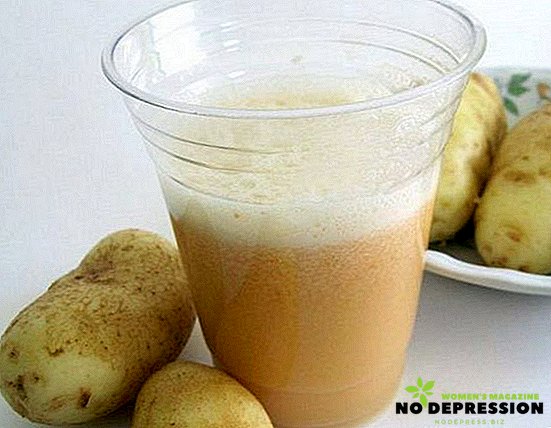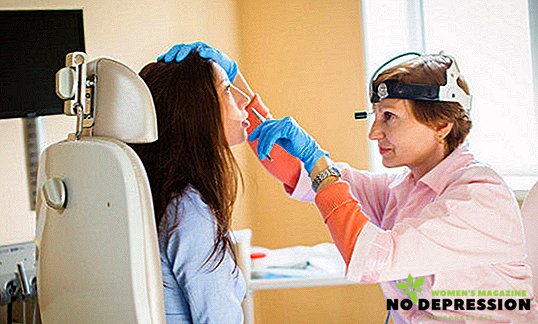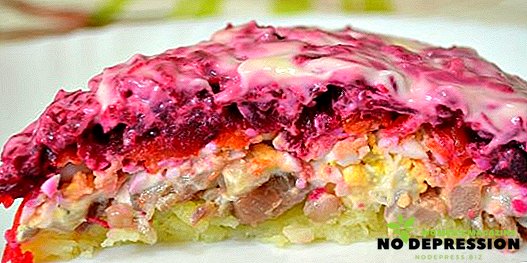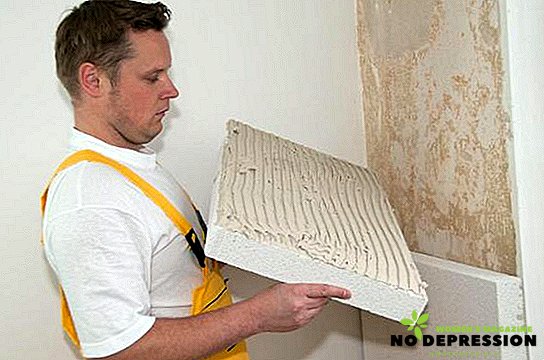Atrophic gastritis is one of the chronic forms of the disease, can lead to a decrease in the amount of hydrochloric acid, anemia, in some cases - to cancer. When late treatment stops the production of hydrochloric acid, injured the stomach due to the thinning of its walls.

In our material we will tell about the main symptoms of the disease and its treatment.
The main causes of
Atrophic gastritis is an extremely dangerous form of chronic gastritis. If time does not begin treatment, this disease can develop into cancer. The causes of the disease are divided into types such as:
Endogenous
These include:
- thyroid disease;
- violations of the restorative function of the epithelium;
- problems in the operation of the nervous regulation or poor blood supply to the stomach walls.
Exogenous
 They are also divided into:
They are also divided into:
- Toxic. This disease appears when dust (eg, coal or metal), arsenic, and other toxic substances enters the body. In addition, tobacco smoking and drinking large amounts of alcohol can lead to this.
- Alimentary. Malnutrition and poor diet can lead to atrophic gastritis. For example, eating large amounts of fatty foods, smoked foods can cause deterioration of the mucous membrane of the stomach.
The disease can flow in different ways. For example, in acute form it develops incredibly fast, while it is accompanied by nausea, vomiting, sharp pain in the stomach, fever. The chronic form in its symptoms resembles acute gastritis.
Types and symptoms of atrophic gastritis
The following types of atrophic gastritis are distinguished. And each of them has its own characteristics and characteristics:
- The initial stage, or subatrophic. It is characterized by the appearance of atrophy on the mucous membrane.
- Antral stage. Pathological processes occur in the area between the stomach and intestines. If time does not begin treatment, the disease moves to other parts of the stomach. As a result of pathological changes, the production of hydrochloric acid stops, which leads to the appearance of ulcers or scars on the mucous membrane.
- Focal. At this stage, the gastric mucosa is damaged, which stops the production of pepsin, which is necessary for the normal functioning of the gastrointestinal tract.
- Multifactorial stage. It is considered one of the most severe forms, as a result of which the entire stomach section is damaged. Left untreated, it leads to cancer.
In addition, atrophic gastritis can be acute or chronic. Let's look at their symptoms.
Acute
When this form inflames the walls of the stomach, there is a full blood vessels. Refers to a complex disease with a bright clinical picture: fainting, fever, severe pain. If untreated, some patients may die from intoxication.
Chronic
Chronic atrophic gastritis often occurs after the acute form. This disease is lethargic, can develop over many years. Characterized by inflammation in the sinewy tissue, mucous membranes, can affect the esophagus and liver.
With increased acidity
 In this case, the mucous is constantly inflamed, small ulcers appear on it. The main features of this form of the disease include:
In this case, the mucous is constantly inflamed, small ulcers appear on it. The main features of this form of the disease include:
- burning;
- sour burp;
- decrease or complete lack of appetite;
- swelling.
In this case, treatment is aimed at suppressing the formation of hydrochloric acid. The important point - you need to follow a diet, include in the diet products that will not irritate the mucous.
With low acidity
With a low secretory function, atrophic gastritis develops with a reduced level of acidity. This type of disease for a long time does not manifest itself, but the digestive process is disturbed. As a result, the following symptoms are observed:
- aching pains in the stomach;
- weight loss;
- heaviness;
- appearance of metallic taste in the mouth.
How is the diagnosis
The diagnosis will be based on an analysis of the symptoms of the disease, analyzes taken, including a study of the biopsy specimens of the coolant, as well as a diagnosis for the presence of Helicobacter pylori.
Functional diagnostics should include the following:
- Measurement of acidity, which will determine the secretory ability.
- Study of the activity of gastric enzymes.
- Diagnosis of the digestive tract, for which gastrography.
It is obligatory to study for the presence of the bacterium Helicobacter pylori, since in most cases all forms of gastritis arise precisely because of it.

Effective treatment of the disease
Treatment includes drug therapy and maintenance of a special diet. If you start treatment on time and follow all the recommendations of the doctor, you can count on a favorable result without further relapses.
Most often, doctors prescribe:
- means that will help to establish the production of hydrochloric acid;
- drugs that restore the gastric mucosa;
- anticholinergics and gastroprotectors.
Also, after examining the diagnosis and the tests provided, the specialist prescribes therapy, which depends on the type of the disease. Let's take a closer look.
 In case of antral atrophic gastritis, treatment is carried out with the help of antibacterial medicines, enveloping drugs. Do not forget about the diet.
In case of antral atrophic gastritis, treatment is carried out with the help of antibacterial medicines, enveloping drugs. Do not forget about the diet.
At the moderate stage take antibacterial drugs, anticholinergic. It will take a complete rejection of bad habits. In the case of a disease with metaplasia, concomitant medication is prescribed; in the absence of results, surgery is indicated. Requires a strict diet.
If the problem is high acidity, you need to take painkillers, antacids, antibiotics, if the disease is caused by the bacterium Helicobacter pylori. When it comes to a reduced level, take antimicrobial agents, antibiotics, drugs that activate the promotion of food lumps. Vitamins can also be prescribed to maintain immunity.
In the case of erosive gastritis prescribed:
- drugs with antisecretory action;
- antacids;
- enzymes aimed at restoring the work of the stomach;
- alkaline mineral water.
When they talk about focal type of gastritis, you need to take antibacterial drugs, restoring complexes, painkillers.
But if the chronic form, then therapy involves taking medication, quitting smoking and alcohol, diet.
In any case, treatment should be under the supervision of a physician.
The scheme of treatment of atrophic gastritis involves the following:
- The course of medication - from a week to 10 days.
- Each course is a combination of several drugs depending on the type of the disease.
- Maintaining a diet and dietary correction.
And it is necessary to visit the doctor at least once every two weeks.
Will popular treatment methods
Additionally (just so, and not as the main therapy) gastritis can be treated with traditional methods. The most commonly used drugs are:
- Broth against inflammation based on mint, lemon balm, elderberry. Take herbs in equal proportions, fill with boiling water, strain and take three times a day.

- Take a teaspoon of honey in the morning, always with cold water.
- You can drink weak green tea before meals.
- To protect the mucous, you need to take a decoction of flax seeds - during exacerbation, drink 1 tsp. before eating.
- Painful attacks well removes potato juice. Take 0.5 cups before meals.

- Infusion of parsley roots: finely chop the roots, add water, leave for a day. For half an hour before meals take 1 tbsp.
- Plantain leaves infusion. Take the leaves, rinse them, twist or finely chop with a knife, cover with water. Take throughout the day for 200 ml.
- To mucous healed faster, you need to drink before eating fresh cabbage juice.
Proper diet for atrophic gastritis
As we have said, diet is an integral part of the treatment. There are 4 most effective diets that should be followed. These include:
Basic
 Assumes good nutrition and stimulation of the functional glands.
Assumes good nutrition and stimulation of the functional glands.
The dishes recommended for this diet should be stewed or baked, you should not include in the diet chilled products of rough structure, too hot dishes, the food should be a little warm.
Diet number 2 allows the inclusion in the diet of a variety of foods: meat, fish, eggs, flour products, vegetables, fruits, cereals, and preferably on the water.
Strict
Appointed with pain syndrome. Its main task is to ensure the minimum load on the body. From the diet you need to eliminate foods that stimulate the receptors of the stomach. In addition, the food itself must be in liquid form, steamed.
When do they prescribe these diets? We will examine in more detail:
- Diet number 1 is shown after pain symptoms subside. It will help restore the inflamed mucous membrane, to establish the function of the stomach.
- Diet number 4 is prescribed for pronounced enteral signs, it is also prescribed for intolerance to dairy products. Its main task is to normalize the work of the stomach by relieving inflammation.
As we have said, atrophic gastritis can turn into stomach cancer. A particular threat is the stage of gastritis, caused by a low level of acidity, in this case, the likelihood of oncology increases by 15%.
To avoid stomach cancer, you should consult a doctor as soon as possible, who will be able to diagnose in time and prescribe a suitable treatment.














